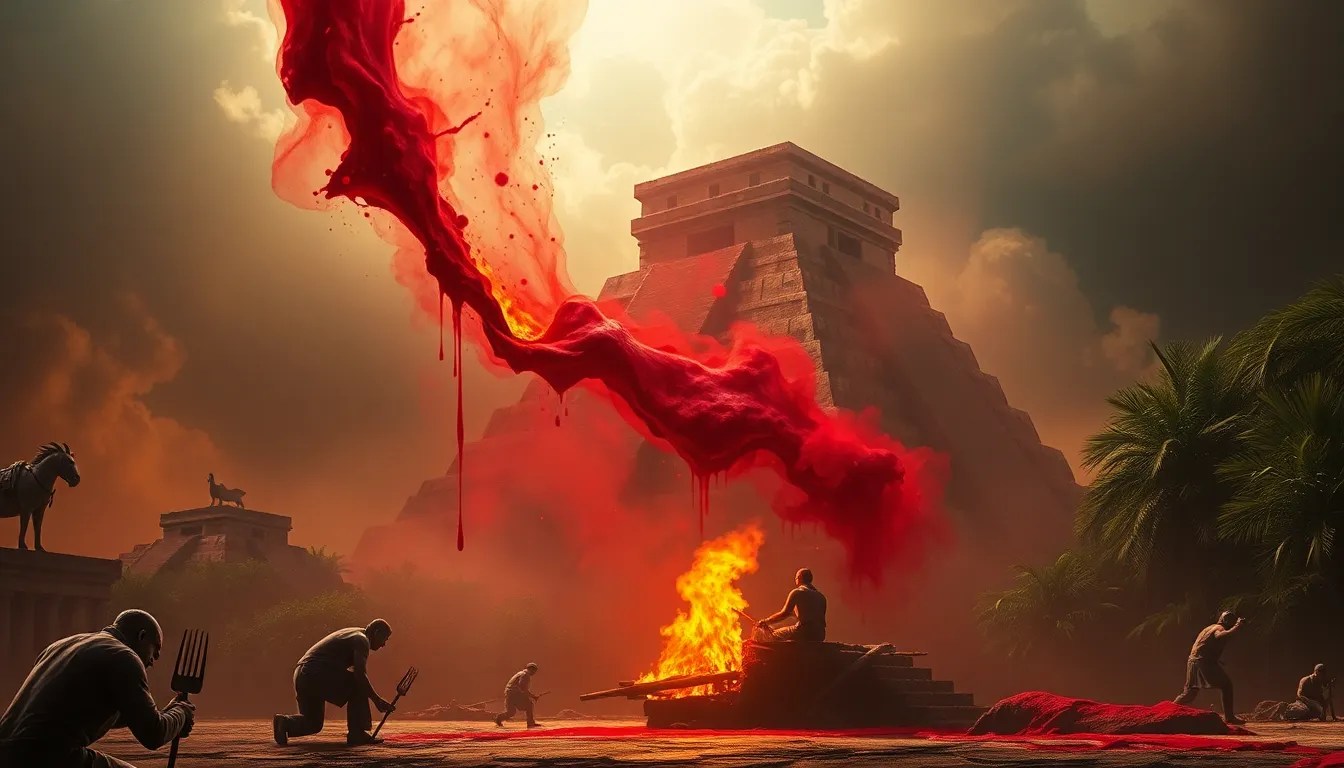Blood and Creation: How Mayans Linked Sacrifice to Life
I. Introduction
Mayan mythology is a rich tapestry woven from stories that explain the cosmos, the creation of humanity, and the divine. It holds significant cultural importance, reflecting the values, beliefs, and practices of the ancient Maya civilization. One of the most profound aspects of Mayan belief systems is the critical role that blood and sacrifice play within these narratives.
Blood was not merely a biological substance for the Maya; it was seen as a sacred life force, integral to both the existence of the gods and the cyclical nature of life. This article aims to explore how the Maya linked sacrifice to creation, illustrating the profound interdependence between these elements in their cosmology.
II. The Role of Blood in Mayan Cosmology
In Mayan cosmology, blood symbolizes the essence of life. It is revered and considered a powerful entity that connects the physical and spiritual realms. The Maya believed that the gods created humans from maize, but it was the blood from their own bodies that endowed humanity with life.
- Blood as a Life Force: The Maya viewed blood as the essence that nourished both gods and humans. It was believed that the gods required blood to sustain themselves and maintain cosmic order.
- Connection to the Gods: The act of shedding blood, whether through ritual or sacrifice, was seen as a way to communicate with and appease the gods, ensuring their favor and the balance of the universe.
- Cyclical Nature of Existence: The Mayans understood life, death, and rebirth as a continuous cycle. Blood played a central role in this cycle, representing the idea that death leads to new life, creating a profound connection between the two.
III. Creation Myths and the Role of Sacrifice
The Mayans had several creation myths that illustrate the significance of sacrifice. One of the most prominent stories involves the gods Tepeu and Gucumatz, who collaborated to create the world. In their endeavors, they realized that human beings were necessary to worship them and maintain the cosmic balance.
- Divine Sacrifices: The gods sacrificed parts of themselves, including their blood, to create the first humans. This act signifies that creation is intertwined with sacrifice, laying the groundwork for human existence.
- Interdependence: These myths reflect the belief that for life to flourish, sacrifice is required. The cycle of giving and receiving is central to the Mayan understanding of existence.
IV. Ritual Practices: Sacrifice as a Means of Nourishment
Ritual sacrifice was a significant aspect of Mayan culture, encompassing various forms, including animal and human sacrifices. These acts were not performed indiscriminately; they were deeply ritualistic and carried profound meanings.
- Types of Sacrifices:
- Animal Sacrifices: Commonly included the offering of birds, deer, and other animals.
- Human Sacrifices: Considered the ultimate offering, usually reserved for significant occasions or to appease powerful deities.
- Ritualistic Context: Sacrifices were performed in ceremonial settings, often accompanied by prayers, music, and other offerings to create a sacred atmosphere.
- Sustenance of Gods: The Maya believed that the gods were nourished by these sacrifices, reinforcing the idea that life and death are interconnected through acts of devotion.
V. The Duality of Life and Death in Mayan Sacrificial Practices
The Maya’s understanding of life and death was complex, with rituals often reflecting a delicate balance between the two. Sacrifice was seen not just as an act of giving but as a transformative experience.
- Balance in Rituals: The Maya believed that every act of sacrifice brought about a balance between life and death, ensuring that neither realm dominated the other.
- Transformative Power: Sacrifice was viewed as a means of transformation, where the loss of life could lead to new beginnings and the revitalization of the community.
- Shaping the Worldview: This duality shaped the Mayan perception of existence, where death was not an end but a gateway to renewal.
VI. The Influence of Sacrifice on Agriculture and Society
The agricultural cycles of the Maya were closely linked to their sacrificial practices. The Maya believed that their rituals could influence the fertility of the land and the abundance of their crops.
- Sacrificial Rituals and Agriculture: Rituals often coincided with planting and harvest seasons, where sacrifices were made to ensure a bountiful yield.
- Community Involvement: Sacrificial practices were communal events, fostering social cohesion and reinforcing societal hierarchies within Mayan communities.
- Ensuring Prosperity: The Maya viewed sacrifices as essential for ensuring the prosperity and fertility of their lands and people, linking their agricultural success directly to their spiritual practices.
VII. Legacy of Mayan Sacrificial Beliefs in Contemporary Culture
Even today, the themes of sacrifice and reverence for life continue to resonate within modern Maya communities. Many of the ancient practices have evolved, yet their roots remain evident in contemporary spiritual beliefs.
- Continuation of Themes: Modern Mayan rituals often reflect ancient beliefs about sacrifice, highlighting the enduring significance of these practices.
- Influence on Spiritual Beliefs: The concepts of life, death, and rebirth that were central to ancient Mayan culture still influence the spiritual frameworks of contemporary Maya.
- Relevance Today: Discussions surrounding life and death are still informed by Mayan sacrificial beliefs, contributing to broader conversations about existence in today’s world.
VIII. Conclusion
In summary, blood and sacrifice are foundational elements within Mayan creation myths, deeply influencing their worldview and cultural practices. The interconnectedness of sacrifice and creation reflects a broader understanding of the cyclical nature of life and death in Mayan thought.
As we reflect on these ancient beliefs, we gain deeper insights into the Mayan civilization and its enduring legacy in contemporary culture. The themes of sacrifice as a means of nurturing life and sustaining cosmic balance offer valuable lessons that continue to resonate in our understanding of existence today.



